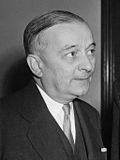June 1946 French legislative election
From Wikipedia, the free encyclopedia
Legislative elections were held in France on 2 June 1946 to elect the second post-war Constituent Assembly designated to prepare a new constitution. The ballot system used was proportional representation.
This article relies largely or entirely on a single source. (January 2013) |
| ||||||||||||||||||||||||||||||||||||||||||||||||||||||
All 586 seats in the French National Assembly 294 seats needed for a majority | ||||||||||||||||||||||||||||||||||||||||||||||||||||||
|---|---|---|---|---|---|---|---|---|---|---|---|---|---|---|---|---|---|---|---|---|---|---|---|---|---|---|---|---|---|---|---|---|---|---|---|---|---|---|---|---|---|---|---|---|---|---|---|---|---|---|---|---|---|---|
| Turnout | 81.85% ( 2.02pp) | |||||||||||||||||||||||||||||||||||||||||||||||||||||
| ||||||||||||||||||||||||||||||||||||||||||||||||||||||
 Results by department | ||||||||||||||||||||||||||||||||||||||||||||||||||||||
| ||||||||||||||||||||||||||||||||||||||||||||||||||||||
After the liberation of France in the Second World War, three parties dominated the political scene due to their participation in the Resistance to the German occupation: the French Communist Party (PCF), the French Section of the Workers' International (SFIO, socialist party) and the Popular Republican Movement (MRP) Christian democratic party. They formed a provisional government led by General Charles de Gaulle.
General de Gaulle advocated a strong presidential government. He felt that the "regime of the parties" under the French Third Republic's system of parliamentary government (characterised by its political instability and ever-changing coalitions) was a cause of the 1940 collapse. However, the three main parties considered parliamentary democracy to be inseparable from the ideology of French republicanism. To them, de Gaulle's project appeared to be a rebirth of Bonapartism. In January 1946 de Gaulle resigned from the cabinet.
The socialist Félix Gouin succeeded him. A first constitutional draft was approved by the National Assembly. It was supported by the Communists and the Socialists. It concentrated power in a unicameral Assembly and abolished the Senate of France. The Christian-Democrats campaigned for the "No" with de Gaulle and the opponents to a constitutional change (the classical Right and the Rally of the Republican Lefts dominated by the Radical Party).
The "No" coalition warned the voters against the danger of a "dictatorship" of an Assembly dominated by the Marxists, which could question the existence of private property. In the "Yes" coalition, the SFIO refused the communist proposition of a common campaign. Finally, the "No"s won by 53% of the votes in a May 1946 referendum.
Consequently, a new National Assembly was elected in order to elaborate a new constitutional draft. The MRP, which led the "No" coalition, became the largest party with more votes and seats than the PCF. The Communists and the Socialists no longer formed a majority, so the MRP was a necessary partner for the writing of a constitutional text. Its leader Georges Bidault took the lead role in the provisional government.
Results
| Party | Votes | % | Seats | |
|---|---|---|---|---|
| Popular Republican Movement | 5,589,059 | 28.11 | 160 | |
| French Communist Party | 5,199,111 | 26.15 | 146 | |
| French Section of the Workers' International | 4,187,818 | 21.06 | 115 | |
| Republican Party of Liberty | 2,539,845 | 12.78 | 62 | |
| Radical Socialist Party | 2,295,119 | 11.54 | 39 | |
| Others | 69,789 | 0.35 | 0 | |
| Total | 19,880,741 | 100.00 | 522 | |
| Valid votes | 19,880,741 | 98.35 | ||
| Invalid/blank votes | 334,459 | 1.65 | ||
| Total votes | 20,215,200 | 100.00 | ||
| Registered voters/turnout | 24,696,949 | 81.85 | ||
| Source: Nohlen & Stöver[1] | ||||
References
Wikiwand - on
Seamless Wikipedia browsing. On steroids.




